Although many buildings look similar at first glance, the underlying materials greatly affect cost and durability — especially in an extreme situation like a fire. All buildings are given a classification from Type 1 to Type 5, and this building type gives crucial information about how fire-resistant a building is.
Some modern buildings have become stronger and cheaper to build, but manufactured materials like engineered lumber and synthetic plastics don’t handle fire well, leading to quick structure collapses and dangerous situations for firefighters.
The most fire-resistant buildings, Type 1 structures, are constructed with concrete and protected steel, materials that are able to withstand high temperatures for a long time. By contrast, Type 5 structures, the least fire-resistant, are lightweight structures made of combustible materials that can collapse soon after catching fire.
- Type 1: Fire-resistive: High-rise buildings made of concrete and protected steel.
- Type 2: Non-combustible: Newer buildings with tilt slab or reinforced masonry walls and a metal roof.
- Type 3: Ordinary: New or old buildings with non-combustible walls but a wood-framed roof.
- Type 4: Heavy Timber: Older buildings with thick lumber used for structural elements.
- Type 5: Wood-framed: Many modern buildings with combustible framing and roofs.
Type 1: Fire-Resistive
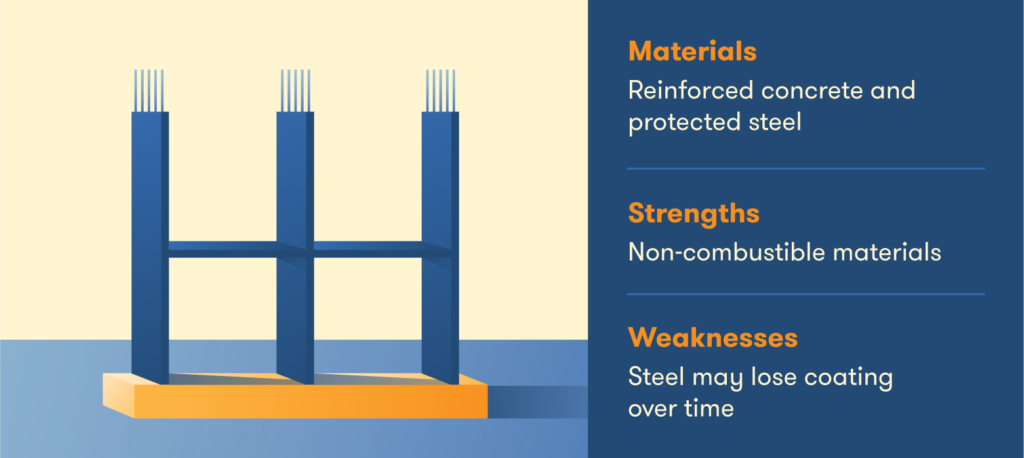
High-rise buildings are Type 1, which are classified as fire-resistive. Generally speaking, these buildings are more than 75 feet tall, including high-rise housing and commercial spaces. Because of their materials and design, Type 1 buildings are considered the most robust in case of fire, able to withstand high temperatures for a long time without collapsing.
When firefighters encounter Type 1 buildings, their main goal is to secure stairwells to ensure a safe evacuation.
- Materials: Reinforced concrete and protected steel (steel covered in a fire-resistant coating).
- Strengths: All structural materials are non-combustible, fire-resistant for up to four hours, and not vulnerable to collapse.
- Weaknesses: Steel can be exposed over time as protection wears down. Roofs and windows cannot easily be penetrated to allow ventilation in case of fire.
- Special notes: Some Type 1 buildings have specialized HVAC systems and self-pressurizing stairwells that mitigate fire spread.
Type 2: Non-Combustible
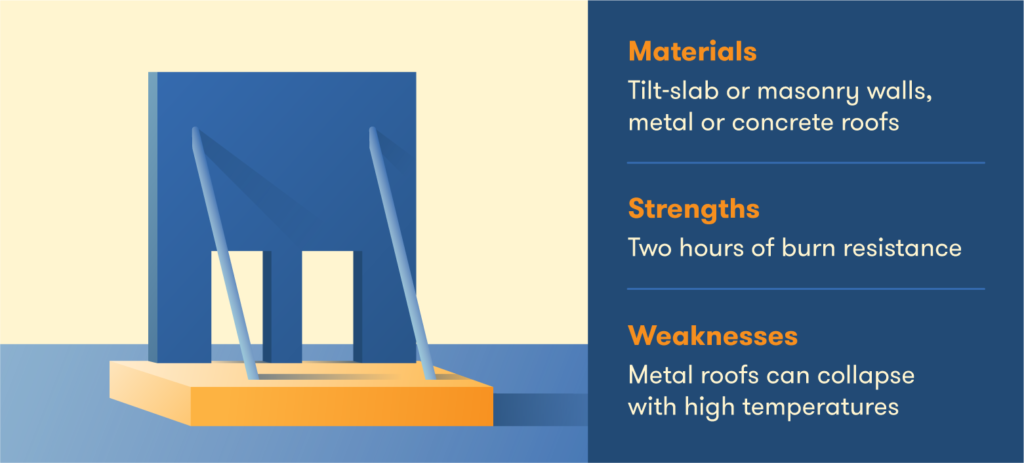
Many new or recently renovated commercial structures — including “big box” stores and large shopping malls — are Type 2 buildings. While these buildings generally have fire suppression systems, they are nonetheless prone to collapse due to their metal roofs, which fail at high temperatures even if they aren’t directly affected by the flames.
When firefighters encounter these buildings, their main priority is to ventilate the building in order to prevent flashover, which is a sudden and dangerous rise in temperature.
- Materials: Walls are either tilt-slab construction or reinforced masonry, both non-combustible. Roofs are usually made of metal and lightweight concrete, which are non-combustible, but some combustible materials like foam and rubber may be present.
- Strengths: One to two hours of burn resistance, depending on the types of materials used.
- Weaknesses: Without sufficient ventilation, temperatures can quickly rise, leading to collapse.
- Special notes: Firefighters often aim to ventilate these buildings through the use of skylights or roll-up doors on the exterior of the building.
Type 3: Ordinary
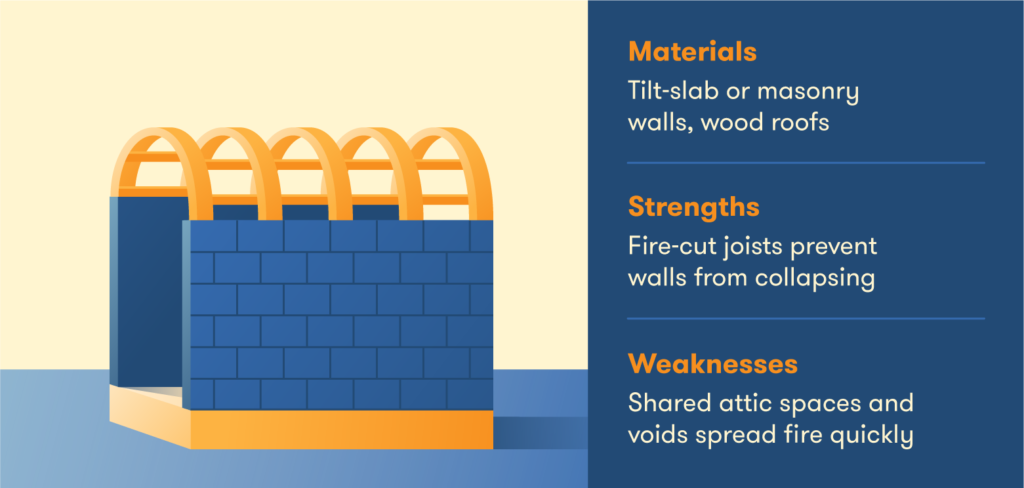
Both new and old buildings — like schools, businesses, and houses — can use the “ordinary” construction that distinguishes Type 3 buildings, which consist of non-combustible walls with wood roofs. Though all Type 3 buildings have wood roofs, older buildings tend to have conventionally framed roofs, whereas newer buildings often have lightweight roof systems.
As firefighters approach Type 3 buildings, their priority is to determine whether the building is old or new in order to make appropriate decisions about ventilation.
- Materials: Walls are either tilt-slab construction or reinforced masonry, both non-combustible, while roofs are made of wood, a combustible material.
- Strengths: With a combination of non-combustible masonry and fire-cut joists, exterior walls can stay standing even if the floors collapse.
- Weaknesses: Many buildings of this type have connected attics or horizontal void spaces, which enables the fire to spread rapidly unless fire stops have been installed.
- Special notes: The roof system used in this type of construction — for example, parallel cord truss or panelized roofs — determines what types of cut firefighters must make to ventilate the structure.
Type 4: Heavy Timber
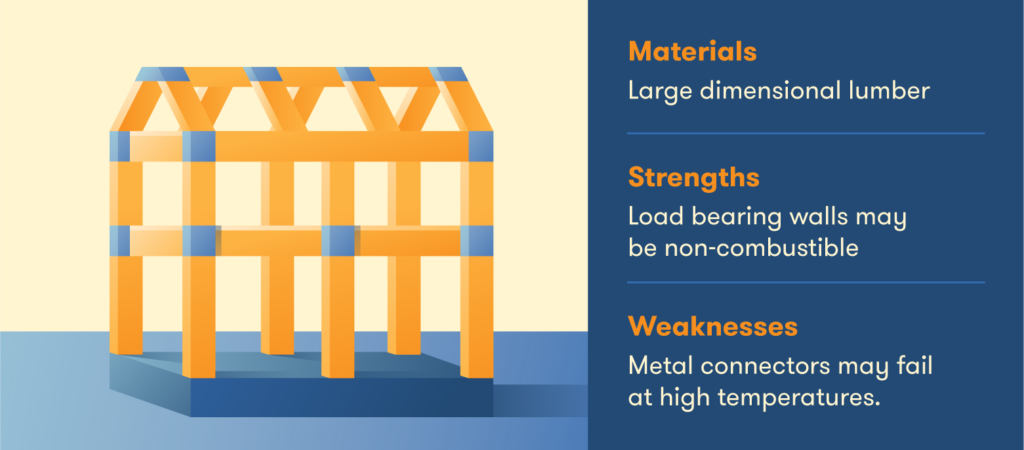
Many buildings were constructed before the 1960s using large pieces of lumber, and these are known as Type 4 buildings. Easily recognized by firefighters, these buildings prominently feature wood in the walls and roof spans — barns, factories, and old churches often use this kind of construction. Throughout the buildings, lumber is connected using metal plates and bolts, forming a robust structure.
Though these buildings are made of combustible materials, they fare surprisingly well during a fire due to the sheer size of the lumber.
- Materials: Large dimensional lumber is used for both the walls and roof.
- Strengths: Sometimes load-bearing walls are non-combustible, and often drains exist, which allows water from firefighters to leave the building without increasing weight and collapse potential.
- Weaknesses: Metal joint connections can fail at high temperatures, and in the case of factories, hazards like oil, machinery, or goods can lead to a rapid increase in fire severity.
- Special notes: Though large dimensional lumber holds up well in fire, older buildings often have damage from termites or weather that increase the risk of collapse.
Type 5: Wood-Framed
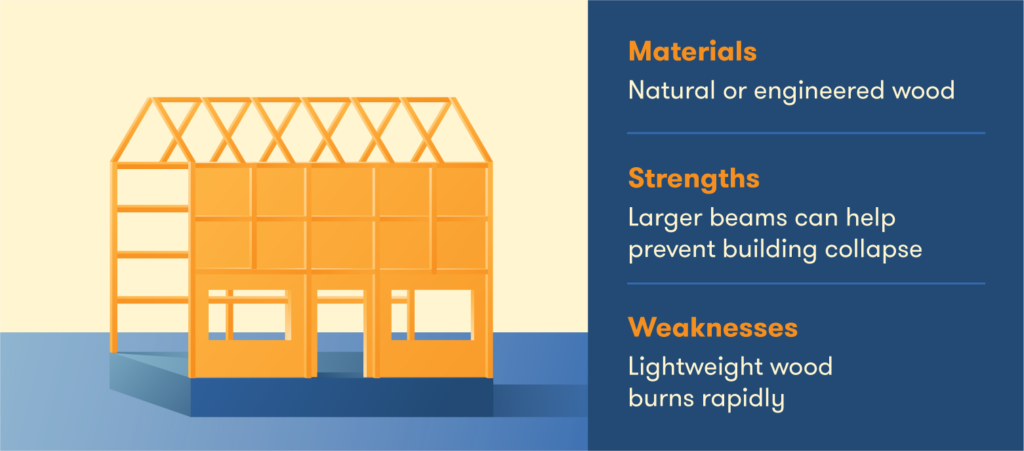
Many modern homes are classified as Type 5 due to their use of combustible materials — usually wood — in both the walls and roof. Unlike the large dimension wood of Type 4 buildings, these Type 5 structures are often made of lightweight or manufactured wood. While this kind of construction is inexpensive, efficient, and structurally sound, it is not at all fire-resistant: Structures of this sort can collapse within minutes after a fire starts.
The one advantage firefighters have in this style of building is the ease with which they can be ventilated due to the wood-framed roofs, but the risk of collapse or flashover is very high.
- Materials: Wood, often manufactured, or other combustible materials used in both the walls and the roof.
- Strengths: If larger beams are used for structural elements, this can help prevent building collapse, and interior platforms often prevent the fire from spreading vertically.
- Weaknesses: Manufactured wood burns easily, and modern construction methods leave buildings at high risk of a fire spreading quickly.
- Special notes: Drywall can help protect structural elements, albeit briefly, but many other materials common in this type of construction will be used as fuel if a fire occurs.
The Importance of Construction Types
An understanding of construction types is absolutely vital for firefighters and anyone in the construction industry, but everyone can get great enjoyment from the structures around them by learning more about the five types of buildings.
Construction workers should have a deep understanding of the ways that different materials and construction techniques contribute to a building’s resilience to fire as well as earthquakes and hurricanes. Just as workers should be prepared for accidents that happen during construction, they should understand how their work contributes to the future safety of the building.
Firefighters must be able to quickly recognize different construction types to form a proper plan of attack. Understanding how fire spreads in different kinds of buildings enables firefighters to make crucial decisions about ventilation and water. A keen sense of construction types saves lives by helping firefighters anticipate dangerous situations like flashover, backdraft, and collapse.
Anyone can gain a greater appreciation of the place they live by understanding construction types — simply walk around and see how many different types of buildings you can find based on their materials and construction style. And when you’re ready to build your own structure, get the equipment you need online.
